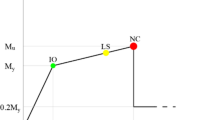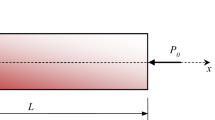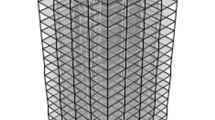Abstract
A novel model for assessing building behavior has been developed by coupling a Bernoulli beam with a quartic stiffness variation and a shear beam with a parabolic stiffness variation, trends that are expected in buildings designed for earthquake actions. Then the partial differential equation of motion governing the behavior of the model has been solved, obtaining analytic expressions (Closed form solutions) for mode shapes in terms of Legendre functions. These closed form solutions were validated with finite element model analyses and effects of non-uniformity of stiffness were assessed in a generalized manner. It was found that period lengthening is mild for the first mode, but for higher modes can be far more noticeable if shear stiffness at beam top is <20 % of its base value. Mode shapes also change notoriously for reductions beyond the same limit, potentially inducing large floor acceleration demands at unexpected locations. Also it was found that drift demands can be noticeably enhanced even if shear stiffness at top is 75 % of the base value, in what would be considered uniform buildings. This model has several applications for assessing the response or large stocks of buildings, calibrate complex models, assess damage on building contents, establishing in short time damage scenarios for large cities, and could be helpful for education, as emphasis is brought back on fundamental concepts.













Similar content being viewed by others
Abbreviations
- EI :
-
Flexural stiffness
- EI 0 :
-
Flexural stiffness at base
- GA :
-
Shear stiffness
- GA 0 :
-
Shear stiffness at base
- H :
-
Building height from soil surface
- IDR:
-
Interstory drift ratio
- M(τ, x):
-
Mehler function of parameter τ
- P(ν, x):
-
First type Legendre function of zero order and ν degree
- Q(ν, x):
-
Second type Legendre function of zero order and ν degree
- q(t):
-
Time variation of mode response
- t :
-
Time
- T n :
-
Normalized vibration period
- u :
-
Displacement
- V :
-
Joint shear on both beams
- V flx :
-
Shear on flexural (Bernoulli) beam
- V sh :
-
Shear on shear beam
- x :
-
Normalized height
- z :
-
Height ordinate about fixed base
- α :
-
Normalized shear to flexural stiffness ratio at the base
- δ :
-
Ratio of shear stiffness between top and base
- ϕ(x):
-
Mode shape
- Γ :
-
Modal participation factor
- ν :
-
Parameter defining order of first and second type Legendre functions
- τ :
-
Parameter or Mehler function
- ρ :
-
Mass per length
- ω :
-
Circular vibration frequency
References
Alimoradi A, Miranda E, Taghavi S, Naeim F (2006) Evolutionary modal identification utilizing coupled shear-flexural response-implications for multistory buildings. Struct Des Tall Spec Build 15:51–65
Alonso A, Miranda E (2014) Seismic response of buildings with non-uniform stiffness modeled as cantilevered shear beams. In: Proceedings of the 10th US National conference on earthquake engineering. N. 1212 Anchorage
Ayre R (1956) Methods for calculating the response of ‘shear’ buildings. In: Proceedings of the first world conference on earthquake engineering, vol 13. Berkely, pp 1–24
Bielak J (1969) Base moment for a class of linear systems. J Struct Div ASCE 95(5):1053–1062
Biot M (1933) Theory of elastic systems vibrating under transient impulse with an application to earthquake proof buildings. Proced Natl Acad Sci USA 19(2):262–268
Brown P, Lowes L (2007) Fragility functions for modern reinforced concrete beam-column joints. Earthq Spectra 23(2):263–289
Charleson A (2007) Architectural design for earthquake, a guide to the design of non-structural elements. New Zealand society for earthquake engineering, Wellington
Chitty L (1947) On the cantilever composed of a number of parallel beams interconnected by cross bars. Philosophical Magazine Series 38(285):685–699
Clough R, Penzien J (1993) Dynamics of structures, 2nd edn. McGraw Hill International Series, Singapore
Computers and Structures INC (2013) SAP2000 – Integrated finite element analysis and design of structures. CSI, Berkeley, California
Csonka P (1965) Simplified analysis for the calculation of multistory frames subjected to wind load. Müszaki Tudományok Osztályának Közleményei 35(1–3):209–229 (in Hungarian)
Hall J, Heaton T, Halling M, Wald D (1995) Near ground motion and its effects on flexible buildings. Earthq Spectra 11(4):569–605
Heidebrecht A, Stafford-Smith B (1973) Approximate analysis of tall wall-frame structures. J Struct Div ASCE 99(2):199–221
Iwan W (1997) Drift spectrum: measure of demand for earthquake ground motions. J Struct Eng ASCE 123(4):397–404
Jacobsen L (1930) Motion of a soil subjected to a simple harmonic ground motion vibration. Bull Seismol Soc Am 20:160–196
Jennings P (1969) Spectrum techniques for tall buildings. In: Proceedings of the 4th world conference on earthquake engineering. Santiago
Khan F, Sbarounis J (1964) Interaction of shear walls and frames. J Struct Div ASCE 90(3):285–335
Li Q, Cao H, Li G (1996) Static and dynamic analysis of straight bars with variable cross-section. Comput Struct 59(6):1185–1191
Lignos D, Koolios D, Miranda E (2009) Fragility assessment of reduced beam section moment connectons. J Appl Mech ASCE 32(1):135–142
Magenes G, Modena C, Da Porto F, Morandi P (2009) Behavior and design of new masonry buildings: recent developments and consequent effects of design codes. In: Eurocode 8 perspectives from the Italian perspectives workshop. Doppiavoice, Napoli, pp 199–212
Miranda E (1999) Approximate seismic lateral deformation demands in multistory buildings. J Struct Eng ASCE 125(4):417–425
Miranda E, Reyes C (2002) Approximate lateral drift demands in multistory buildings with non-uniform stiffness. J Struct Eng ASCE 128(7):840–849
Miranda E, Taghavi S (2005) Approximate acceleration demands in multistory buildings. I: formulation. J Struct Eng ASCE 131(2):203–211
Muto K (1954) Structural design of buildings. Shokoku-Sha Press, Tokyo, Japan
Newmark NM, Rosenbluth E (1971) Fundamentals of Earthquake Engineering. Prentice Hall, Englewood Clifs, NJ
Olver F, Lozier D, Boisvert R, Clark C (2010) NIST handbook of mathematical functions. Cambridge University Press, New York
Osawa Y (1965) Response analysis of tall buildings to strong earthquake motions. Part 1: linear response of core-wall buildings. Bull Earthq Res Inst Univ Tokyo 43:803–817
Pagni A, Lowes L (2003) Predicting earthquake damage in older reinforced concrete beam-column joints. In: PEER Report 2003/17. Pacific earthquake engineering research center, College of engineering, University of California at Berkeley, Berkeley, 2003
Ramirez C, Lignos D, Miranda E (2012) Fragility functions for pre-northidge welded steel moment-resisting beam-to-column connections. Eng Struct 2009(45):574–584
Rubinsten A (1964) Effect of axial deformation on the periods of tall buildings. Bull Seismol Soc Am 54(1):243–261
The Mathworks Inc (2012) MATLAB User's Guide. South Natick, MA
Tso W, Chan H (1971) Dynamic Analysis of Plane Coupled Shear Walls. J Eng Mech Div ASCE. 97(1):33–48
Westergaard H (1933) Earthquake-shock transmission in tall buildings. Eng News Rec 79(III):645–656
Wolfram Research Inc. (2012) Mathematica version 9.0. Champaign, IL
Zhang S, Jian-Ming J (1996) Computation of special functions. Wiley, Hoboken
Acknowledgments
This work is one of the outcomes of the doctoral studies of the first author, at ROSE school, the Earthquake Engineering and Engineering Seismology programme of the graduate school in understanding and managing extremes of the IUSS, Istituto Universitario di Studi Superiori di Pavia, Italy. The first author was also awarded a Dottorato di Ricerca scholarship to carry his studies, therefore extends his gratitude to the Italian Republic, which funded this initiative. The authors would like to mention professors Apostolos Papageorgiou, Diego Lopez García, Rajesh Rupakhety and Christian Málaga who provided valuable comments during the preparation of this manuscript. Also valuable comments by two anonymous reviewers are acknowledged.
Author information
Authors and Affiliations
Corresponding author
Appendices
Appendix 1: Derivation of a solution for the differential modal equation that governs the behavior of a flexural with four order stiffness variation along height coupled with a shear beam with parabolic stiffness variation along height
Consider the following second order differential equations:
A solution of Eq. 37 is:
while a solution of Eq. 38 is:
If Differential operator 37 is applied in Eq. 38, or differential operator 38 is applied in Eq. 1, either way, following is obtained:
where
In the first case where operator 37 is applied to 38, is evident that the solution of differential Eq. 38 is also a solution of 41. In the latter case where operator 38 is applied to 37 the solution differential Eq. 37 is shown to be also a solution of 41. It must be emphasized that both solutions are linearly independent as the zero order terms in Eqs. 37 and 38 are distinct. Therefore a general solution of Eq. 15 can be formulated:
However, the case considered so far involves zero shear and flexural stiffness at top. This is unrealistic, and therefore of no practical interest. Differential equation of a beam with non-zero stiffness at top is:
Following change of variable is proposed:
By substituting Eq. 46 with its derivatives on Eq. 45, following is obtained:
General solution of Eq. 47 is:
If Eq. 46 is replaced in Eq. 48 the general mode shape Eq. 17 will be obtained. A comparison of Eqs. 45 and 47 show that α and ω have been scaled in the following way:
Appendix 2: Computation of Legendre functions
First and Second degree Legendre functions with real order are solutions of Eq. 37. When their order is an integer value, Legrendre polynomials are obtained; as they are orthogonal are widely used in mathematics and physics, being few applications: Gauss Quadrature; Solutions to rime-dependent Schrodinger Equation; fluid dynamics, particularly compressible gasses and vibration in bodies and membranes (Olver et al. 2010).
Solutions to Eq. 38 define Conical or Mehler functions, a particular kind of Legendre functions with a complex degree; still for any real argument, a real outcome is obtained. Particularly, Mehler functions are helpful for solving problems of vibration and heat flow considering toroidal coordinates, which arise in the design of Tokamaks, for example (Olver et al. 2010). It is observed that Legendre functions with real order have an oscillatory nature, crossing the abscissa (zero ordinate) at uneven intervals between 0 and 1; whilst Mehler functions are monotonically increasing or decreasing between 0 and 1. Legendre functions are natively implemented in Mathematica© (Wolfram Research Inc 2012). For this study the authors implemented them in Matlab© (The Mathworks Inc 2012) following algorithms developed by Zhang and Jian-Ming (1996). Higher order derivatives can be computed following recursive relationships (NIST 2012):
or
(52) and (51) applies also to the second type Legendre and Mehler functions. Through chain rule differentiation, successive derivatives can be taken directly:
Rights and permissions
About this article
Cite this article
Alonso-Rodríguez, A., Miranda, E. Dynamic behavior of buildings with non-uniform stiffness along their height assessed through coupled flexural and shear beams. Bull Earthquake Eng 14, 3463–3483 (2016). https://doi.org/10.1007/s10518-016-0009-2
Received:
Accepted:
Published:
Issue Date:
DOI: https://doi.org/10.1007/s10518-016-0009-2




